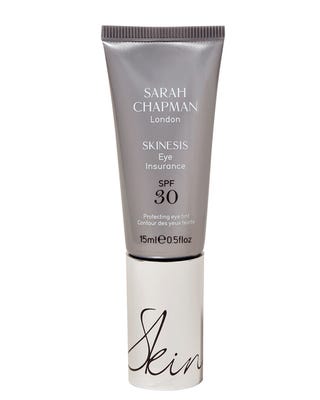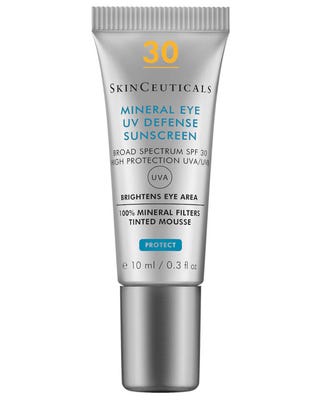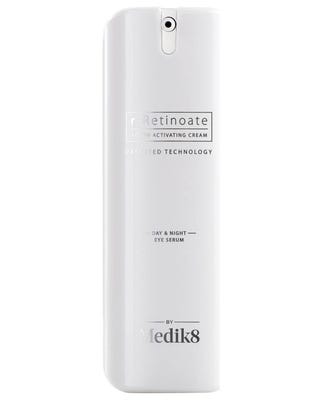How To Get Rid Of Crow's Feet Without Botox
It's no secret that our eyes are one of the first areas to show the signs of ageing. The skin here is 40 per cent thinner than the rest of our face, making it more delicate. While so-called 'crow's feet', AKA the fine lines and wrinkles around the eye area, are totally normal, they're also one of the most common ageing concerns. Should they bother you, here's the Bazaar guide to preventing and reducing them.
What causes lines around the eyes?
"A combination of loss of skin elasticity and collagen, and skin movement are the main causes of crow's feet," explains Dr Michael Prager, one of London's most sought-after aesthetic doctors. As we age, our skin loses elastin (its stretch) and collagen (its plumpness), but sun damage, free radicals and hormone changes elevate this. On average we blink 15–20 times a minute (that's 20,000 times per day), causing the facial muscles to crinkle and almost constantly move. Blinking aside, Mr Kambiz Golchin, a facial plastic surgeon, says "all facial movements, whether they are happy or sad, will eventually cause lines and wrinkles." So when we collectively eye rolled at Kim Kardashian admitting she doesn't laugh often for fear of ageing, she's not misguided – sad though her commitment may be.
How can you prevent them?
While not blinking – and forgoing smiling – isn't an option, you can prevent crow's feet by protecting the area against environmental damage (think UV rays and pollution)
Today's best eye products can be relied upon to disspiate UV rays and free radicals in the environment, preventing crow's feet (amongst other signs of skin ageing) before they occur.
For anyone dubious about the need for a separate eye cream, facialist Kate Kerr explains why it's really worth investing. "During the day your eye care should be all about prevention and protection. When it come to the eyes, we are looking for the same outcome as the rest of the face – a thickening and strengthening of the skin – and it's the same ingredients that do that. However, a targetted eye cream can also address specific concerns such as under-eye circles, loss of collagen and fine lines and wrinkles. Eye-specific skincare is generally formulated to be thinner in texture and with a lower concentration of active ingredients, reducing the chance of irritation."

Eye Insurance SPF 30 by Sarah Chapman
Sarah Chapman spacenk.com.uk
£48.00
It's tricky to find a good eye cream with adequate sun protection, but Sarah Chapman's is perfect. The tinted hue sinks into all skin tones to brighten and illuminate, while the broad-spectrum SPF30 delivers all the protection you need.

Mineral Eye UV Defense SPF30 Sunscreen Protection
SkinCeuticals lookfantastic.com
£28.00
Another smart choice, this formula contains gentle mineral filters to shield from UV rays, and has a sort, mousse-like texture with a redness-concealing tint.

r-Retinoate Day and Night Eye Serum
Medik8 lookfantastic.com
£90.00
It's always best to use a specially formulated retinol under the eyes, as generalised formulas can be too harsh on this delicate skin. Medik8's serum really is the gold standard: it's fast-acting, highly effective, and gentle enough for sensitive types.

C Eye Advance
iS Clinical skimresources.com
US$54.00
This A-list favourite is a heavy-hitting treatment for crow's feet and dark circles. The watery serum is packed with peptides to boost collagen, plumping out wrinkles, as well as stabilised vitamin C to protect from the ravaging effects of pollution.
What treatments help minimise crow's feet?
Botox and fillers
"Traditionally, crow's feet were treated with Botox. The idea was that if we don't move, we don't see the lines," says Dr Prager. However, this doesn't address the lack of collagen. As a result, Dr Prager takes a two-pronged approach: "I go easy on the muscle relaxation (Botox), so the area still has movement, and I add a bit of collagen into the skin using dermal filler injections."
For suitable patients, Mr Golchin recommends injectables too, but he says that in this delicate area you should practice caution. "Serious complications such as double vision or droopy eyelids, are thankfully rare. Occasionally puffiness around the eyelids can occur, but this is usually temporary and will resolve spontaneously." Do note that injectables could actually prevent you from smiling naturally. "Wrong placement or excessive use of products can create an unnatural look," he explains. There's not smiling out of choice, and then there's not smiling because you can't. "Choosing an experienced qualified practitioner is a must."
Skin tightening
"As well as the injectables we often need to tighten the skin using skin tightening machines and energy devices such as radio frequency," says Mr Golchin.
London-based aesthetician Renée Lapino also advocates the use of radio frequency for crow's feet, working with the temperature-controlled device Lumenis NuEra. She explains that when using an attachment designed specifically for the face and smaller areas, it "emits radio frequency waves or thermal energy deep into the skin, combining massage with heating to increase circulation around the around the eyes". A treatment takes about 10-to-15 minutes, is pain-free, and – Lapino says, "you can expect crow's feet to look visibly reduced, softened and a lifted." Improvements should show after one treatment, with optimal results after four-to-six.
Microneedling
Sitting between injectable and topical treatments that promise to counteract the visual effects of ageing lies microneedling, the use of a hand-held device that creates controlled skin injury.
"When there is a small bit of bleeding, platelets leave the blood vessels and get exposed to the surrounding tissue," explains Dr. Prager. "This causes a reaction whereby the platelets excrete hormones and growth factors which cause the stimulation of fibroblasts and other collagen producing cells to start increasing their production. This in turn results in more elastic and rejuvenated skin."
Facial acupuncture
A nice alternative to microneedling is beauty acupuncture. A pioneer in this area, Dr John Tsagaris, is a renowned doctor of Traditional Chinese Medicine. He explains, "beauty acupuncture works by remodelling the skin, encouraging more collagen and elastin production, creating firmer and more resilient skin around the eyes." It's not painful, and there's no downtime. "It also improves microcirculation that helps with puffiness and discolouration issues, " he adds. Visit Dr Tsagaris at the Harrods Wellness Clinic.
Lasers
For more serious skin tightening, Mr Golchin uses laser in his practice. "In particular I use a C02 laser because this is a resurfacing laser," he explains. "It allows for the production of brand-new skin which has more collagen and, more importantly, more elastin." The result is rejuvenation of the skin on the eyelid and underneath the eyes.
Be prepared for potential pain, though: Laser treatment is commonly compared to the sensation of a rubber band snapping against the skin, but the level of discomfort depends on your tolerance and the depth of treatment. It goes without saying that you should choose your practitioner carefully.
This content is created and maintained by a third party, and imported onto this page to help users provide their email addresses. You may be able to find more information about this and similar content at piano.io
How To Get Rid Of Crow's Feet Without Botox
Source: https://www.harpersbazaar.com/uk/beauty/skincare/a34611/beauty-sos-how-to-get-rid-of-crows-feet/
Posted by: standleysamough.blogspot.com

0 Response to "How To Get Rid Of Crow's Feet Without Botox"
Post a Comment